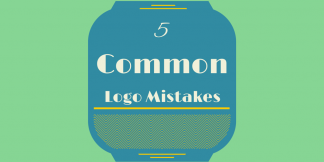The logo is one of the most important parts of a brand. Why do you think that the logo design is always changed when a company goes through rebranding? It’s because the logo is the visual representation of the brand and what the company embodies.
A good logo doesn’t take a member of Mensa to figure out, if it does, then your logo is not accomplishing the task a logo should accomplish. The logo should tell the story about your business in a clear, quick, and genuine manner.
Designing a logo can be incredibly tough, even for large corporations. Look at companies like GAP, Pepsi, Airbnb, etc. They all came out with new logos in the last few years and they’ve all been ridiculed; GAP’s decision was met with such distaste that they reversed the decision on the new logo within a week of debuting it.
Brands make mistakes when they change logos as well as when they create them. We’re human.
So what are these 5 common logo mistakes?
- Using resolution-dependant pixel-based graphics. You must make sure that logos scale in a correct way for their host devices. Every time the logo is published on something, it has to have consistent quality; this consistent quality means that you can’t have pixelating images, this is a consequence of using raster graphics. Vectors make things a lot easier. If the logo is going to be online, then using HTML5 is a nice pairing with scalable vector graphics so you can embed the logo right into the code, without drama.
- Basing the design off of trends and fads. Trends and fads happen for a reason, they are appealing and catchy. However, a logo is supposed to last a brand a long time; fads and trends tend to expire well before a logo will (or at least should). Consequently, when you have a logo that is based on a fad, it will look current and cool for a while but then outdated and a drag on the brand. One current trend in logos is the matte, minimalistic design. Could this design survive? We’ll see (for examples, look at Google, Walmart, or Olive Garden, among others).
- Poorly-planned typefaces. Combining two clashing fonts or using one that doesn’t embody the brand can result in a bad outcome. I’m sure we all just thought of Comic Sans here. If you’re a financial planner, lawyer, or something in the C-suite level, then using a typeface that carries that sense of professionalism. Certain things to consider when choosing a typeface:
- What the company does
- Are they formal or informal?
- Does the font match the design?
- Does the negative space help the logo?
- Look at FedEx’s logo, there’s the arrow between the E and X pointing to the right (forward). This suggestions speed, direction, and progress.
- Are there too many fonts?
- What the company does
- Copying successful brands. Unless your brand is mimicking a brand, then making yours appear like another logo in use is tacky and lazy. It’s like trying to ride to coattails of someone else’s success.
- Making the logo too complicated, busy. Nothing confuses consumers than a logo that has too much going on. It’s cute if a grocery store uses a vegetable or fruit as part of the logo but does every letter have to be a different food item? It’s better to be simple because:
- Impact is faster: They need to be able to read it and know what it is quickly.
- Easier to remember: Simpler logos are easier to remember in our minds.
- Nicer reproduction: Suppose your logo will now be on items of clothing instead of just print materials. It will be a lot easier to put that on clothes when it is an easy logo to reproduce.
Tags: chicago graphic design, chicago logo design, graphic designer in chicago, graphic designer in los angeles, graphic designers in new york city, great graphic designers in Chicago, great graphic designers in LA, LA graphic design, logo design in LA, los angeles graphic design, los angeles logo design, new york graphic design

